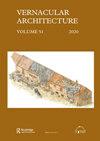康沃尔基底-褶皱特拉斯
IF 0.3
4区 艺术学
0 ARCHITECTURE
引用次数: 1
摘要
描述了四座带有底座龙骨桁架的康沃尔建筑,这是一个独特的建筑群的一部分,这些建筑群的特点是叶片穿过系梁,夹住拱廊板。根据环宽和稳定同位素树木年表,它们的年代确定为13世纪末至14世纪末,是康沃尔已知最早的世俗建筑。本文讨论了这些桁架如何与全国基础结构的发展联系起来,并将这些建筑置于更广阔的历史背景中。本文章由计算机程序翻译,如有差异,请以英文原文为准。
The Cornish Base-Cruck Truss
Four Cornish buildings with base-cruck trusses are described, part of a distinctive group that share the feature of having the blades passing the tiebeams to clasp the arcade plates. They have been dated, using a combination of ring-width and stable-isotope dendrochronology, to between the late thirteenth and late fourteenth centuries, making them the earliest known secular buildings in Cornwall. The paper discusses how these trusses relate to the development of the base-cruck form nationally and sets the buildings into their broader historical context.
求助全文
通过发布文献求助,成功后即可免费获取论文全文。
去求助
来源期刊

Vernacular Architecture
ARCHITECTURE-
CiteScore
0.70
自引率
50.00%
发文量
1
期刊介绍:
Vernacular Architecture is the annual journal of the Vernacular Architecture Group, which was founded in 1952 to further the study of traditional buildings. Originally focused on buildings in the British Isles, membership and publications have increasingly reflected an interest in buildings from other parts of the world, and the Group actively encourages international contributions to the journal.
 求助内容:
求助内容: 应助结果提醒方式:
应助结果提醒方式:


